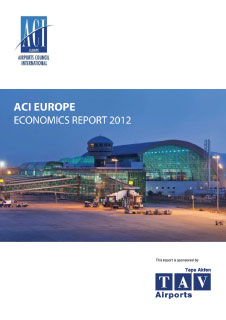
The newly released ACI EUROPE Economics Report 2012 analyses aggregate financial data for the European airport industry for the year 2011.
This year’s report – the fourth of its kind – gives an insight into an industry which has found itself squeezed between both supply and demand-side forces in recent years. On the supply side, continued cost increases not only strained airports’ balance sheets, but also required cutbacks which may not be sustainable in the longer run. In particular, between 2009 and 2011 interest costs alone rose by a shocking +45%. As infrastructure providers, such costs are a key component of airport viability, and it was therefore no surprise to see capital investment plans slashed for another consecutive year. It is becoming simply too expensive for airports to justify putting in place the necessary capacity required to meet future demand.
The fixed nature of airports’ costs means that airports have very limited room for manoeuvre where cutbacks are concerned. Most airport infrastructure is considered as ‘sunk’ – it cannot be leased out or sold away. Similarly, many operating costs are inextricably linked to passenger traffic volumes, or unavoidable regulatory requirements concerning safety and security.
This means that airport cost cutting must be focused in a few key areas, and where it is focused, it must go deep. For example, staff costs alone have decreased by -8% or €660m between 2009 and 2011. Similarly sales and marketing costs decreased by -29% in the same period. While the overall immediate impact is positive – operating costs per passenger decreased by -6% since 2009 – the focused nature of these cuts risks unduly impacting service quality levels. Airport users and in particular airlines need to engage closely with airlines to determine the optimal trade-off between price and quality. And cutbacks should not unduly undermine airport efforts to grow traffic, as the sharing of fixed capital costs amongst a wider pool benefits all parties.
On the demand side, airports can no longer simply pass through these cost increases to users. The intensity of airport competition continues to grow. With both airlines and passengers increasingly free to choose between individual airports, and with airlines enjoying greater buyer power, increasing aeronautical revenue for airports is no longer simply a matter of rising airport charges. Aeronautical revenues per passenger only rose by +2.2% in 2011. EU inflation figures of +3.1% meant that this represented a decrease in real terms. This development was in the context of a pre-existing trend in 2009 and 2010, when 69% and 64% of airports respectively lowered or froze their charges.
Airports remain very much dependent on non-aeronautical revenues to keep the business running – which accounted for 41% of overall revenues once ground handling and non-categorised income was excluded – but here also difficulties were being faced. Consumer sentiment remained weak throughout 2011, and the various commercial innovations and new approaches adopted by airports and their commercial partners were sufficient only to maintain at a stable level passengers’ propensity to spend. While this represents a considerable achievement within a very difficult trading environment, it does not help airports escape with the wider financial squeeze they are experiencing.
The outcome of this situation was very visible when profitability was considered. In 2011, 42.5% of airports were loss making. Once non-operating income was accounted for, this figure rose to 50.9%. This in part reflects the reality that smaller airports are structurally loss making. However, the pain was not restricted to these airports, with a representative sample of airports recording a Return on Capital Employed of just 4.3% – far below levels which can be considered sustainable.
The ACI EUROPE Economics Report 2012 sheds light on what was a difficult year for the majority of European airports. It is freely available to download from the Policy Library on www.aci-europe.org.







